The AMD Radeon R9 Nano Review: The Power of Size
by Ryan Smith on September 10, 2015 8:00 AM ESTCompute
Shifting gears, we have our look at compute performance.
Starting us off for our look at compute is LuxMark3.0, the latest version of the official benchmark of LuxRender 2.0. LuxRender’s GPU-accelerated rendering mode is an OpenCL based ray tracer that forms a part of the larger LuxRender suite. Ray tracing has become a stronghold for GPUs in recent years as ray tracing maps well to GPU pipelines, allowing artists to render scenes much more quickly than with CPUs alone.
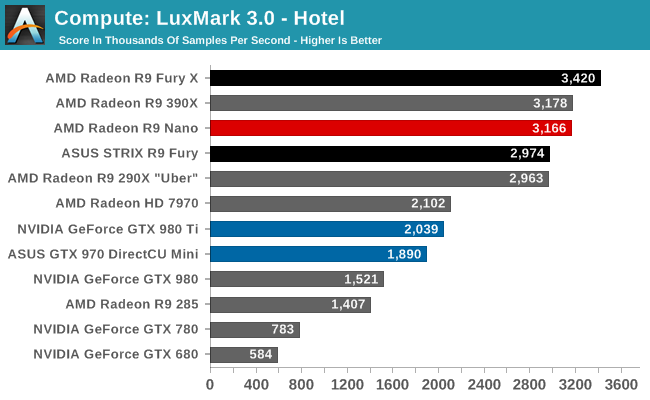
LuxMark ends up being a great corner case for where having a fully enabled Fiji GPU is more important than having the highest clockspeeds. With the R9 Nano able to flirt with its full 1000MHz clockspeed here, the card is able to pass the R9 Fury here. The only thing stopping it from taking the second-place spot is the R9 390X, as Hawaii still sees strong performance here even with fewer SPs.
For our second set of compute benchmarks we have CompuBench 1.5, the successor to CLBenchmark. CompuBench offers a wide array of different practical compute workloads, and we’ve decided to focus on face detection, optical flow modeling, and particle simulations.
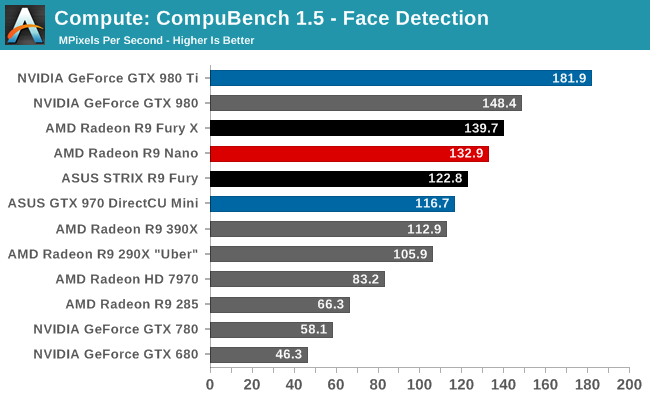
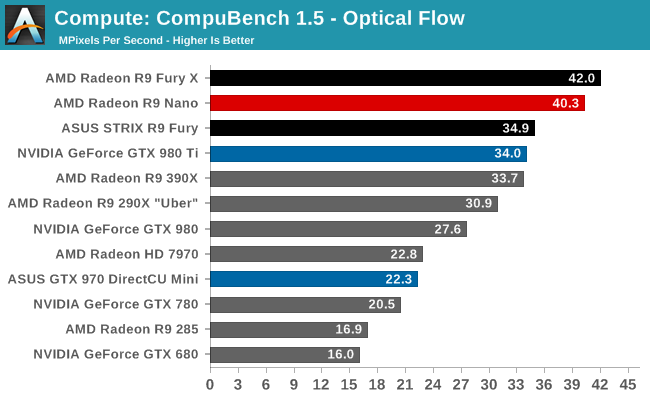
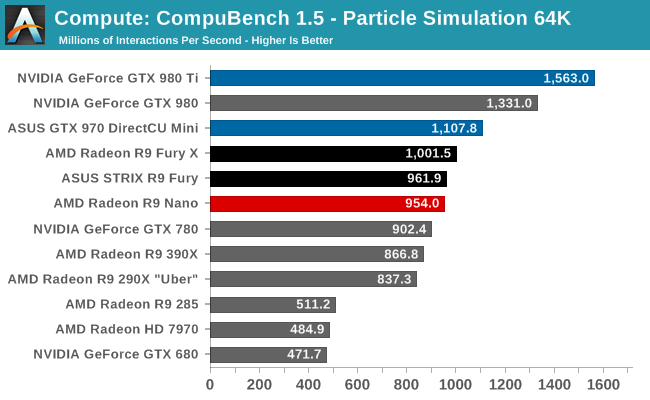
CompuBench provides us another case of where the R9 Nano ends up outpacing the R9 Fury. As a result AMD’s latest card tends to perform somewhere between an R9 Fury and R9 Fury X, with all of the strengths and weaknesses that come from that. This puts the R9 Nano in a good place for Optical Flow, while it will still trail NVIDIA”s best cards under Face Detection and the 64K particle simulation.
Meanwhile it’s interesting to note that AMD’s particle sim scores have significantly improved in the recent drivers. GCN 1.2 cards have seen 20%+ performance improvements here, which may point to some new OpenCL compiler optimizations from AMD.
Our 3rd compute benchmark is Sony Vegas Pro 13, an OpenGL and OpenCL video editing and authoring package. Vegas can use GPUs in a few different ways, the primary uses being to accelerate the video effects and compositing process itself, and in the video encoding step. With video encoding being increasingly offloaded to dedicated DSPs these days we’re focusing on the editing and compositing process, rendering to a low CPU overhead format (XDCAM EX). This specific test comes from Sony, and measures how long it takes to render a video.
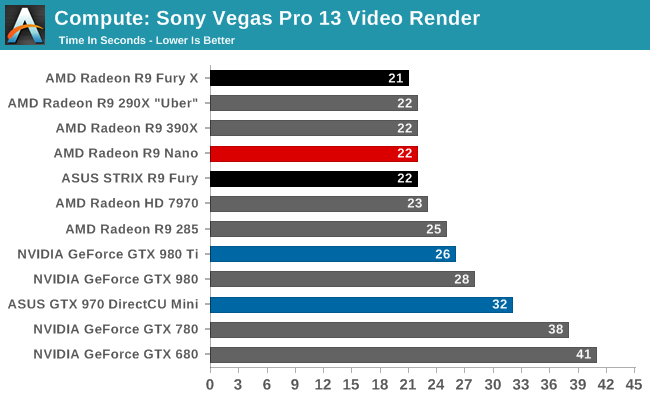
With Vegas there are no surprises; the R9 Nano ties the R9 Fury.
Moving on, our 4th compute benchmark is FAHBench, the official Folding @ Home benchmark. Folding @ Home is the popular Stanford-backed research and distributed computing initiative that has work distributed to millions of volunteer computers over the internet, each of which is responsible for a tiny slice of a protein folding simulation. FAHBench can test both single precision and double precision floating point performance, with single precision being the most useful metric for most consumer cards due to their low double precision performance. Each precision has two modes, explicit and implicit, the difference being whether water atoms are included in the simulation, which adds quite a bit of work and overhead. This is another OpenCL test, utilizing the OpenCL path for FAHCore 17.

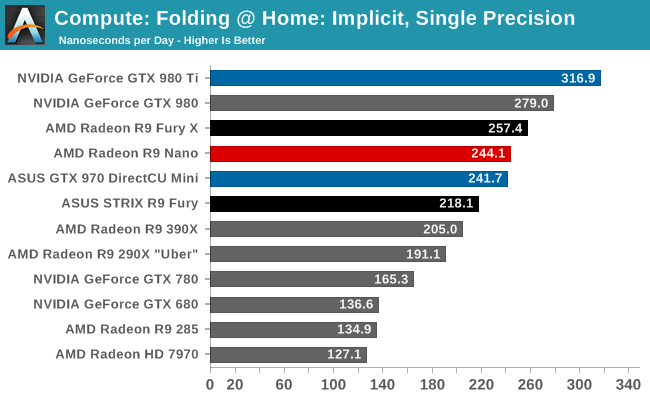
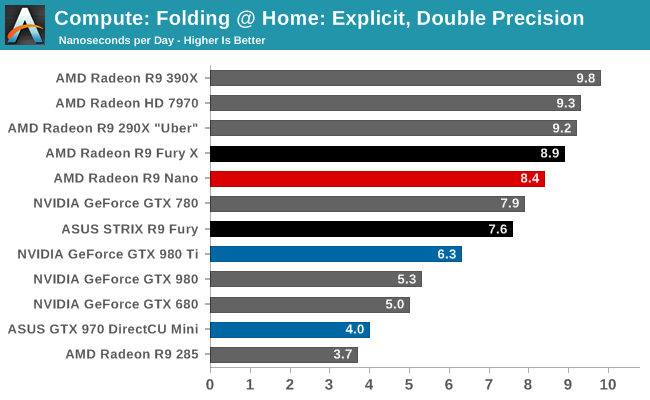
Much like CompuBench and LuxMark, the R9 Nano punches above its weight here. The lack of a graphics workload – and resulting demands on graphics hardware like the ROPs – means most of the card’s power can be allocated to the shaders, allowing higher clockspeeds. This gives the Nano a boost in this situation to bring it much closer to the Fury X, though as far as Folding goes AMD will still trail NVIDIA’s best cards.
Wrapping things up, our final compute benchmark is an in-house project developed by our very own Dr. Ian Cutress. SystemCompute is our first C++ AMP benchmark, utilizing Microsoft’s simple C++ extensions to allow the easy use of GPU computing in C++ programs. SystemCompute in turn is a collection of benchmarks for several different fundamental compute algorithms, with the final score represented in points. DirectCompute is the compute backend for C++ AMP on Windows, so this forms our other DirectCompute test.

Our final test sees the R9 Nano brought back to its place behind the R9 Fury, as the C++ AMP sub-tests are strenuous enough to cause more significant clockspeed throttling. Even behind the R9 Fury the R9 Nano does well for itself here, coming in behind the GTX 980 Ti and head of the R9 390X and GTX 980.










284 Comments
View All Comments
Will Robinson - Thursday, September 10, 2015 - link
Yup,I agree.Dammed with faint praise is the best you'll see for AMD cards there.
Their comments section is an NV fanboy fest led by Chuckula/Chizow and approved by TR.
silverblue - Friday, September 11, 2015 - link
Semiaccurate would've most likely gone the same way had Charlie not locked it all down to subscribers. The only downside is the lack of a daily drashek fix.I think wccftech is another of chizow's haunts, but don't quote me on that.
Gasaraki88 - Friday, September 11, 2015 - link
Oh come on. AMD didn't give a card to Kyle from HardOCP also. So you're saying all the review sites out there are bias against AMD?jardows2 - Friday, September 11, 2015 - link
After reading several recent H's reviews of AMD products, where their testing shows the AMD card slightly slower than the nVidia product, then the conclusion stating the AMD product is a piece of trash and not worth anyone's money, without any of their own testing data backing up such a harsh conclusion, I don't blame AMD for not sending them a card.Alexvrb - Friday, September 11, 2015 - link
Yeah I kind of saw that one coming. I still read H sometimes, but you really have to draw your own conclusions and keep the salt handy. With TR, it's not only what they report, it's what they refuse to report. It's far from the worse, but there's a pattern.AT is my favorite overall, anyway.
InquisitorDavid - Saturday, September 12, 2015 - link
I don't know what your level of 'recent' is, but the R9 380 and R9 390x both got decent reviews. The 390x got a silver award, basically being touted as a cheaper, more power-hungry 980 with more VRAM (truth), and the R9 380 was given a Gold award because it performed better than a 960 at the same price range.The Fury got no awards for being on-par with the stock 980, while costing more. They saw the 390x having better value (thus the silver award), despite the increased power draw.
If anything, AMD has been getting a lot of crap because they've been losing for a while now. Less efficiency, rebrands, and all. OC'ing the 390x gets it to the same level as a 980 reference, and will consume about 200w more. It's cheaper, however, and we all know that's what AMD has been doing for a while now - value for money. It's the only battlefield they can claim any sort of real victory on. With the Fury and Nano, that gets completely thrown out the window.
The Fury X was hamstrung by the release of the 980ti (which was clearly a blocking maneuver by NV). Without the 980ti, it would've been the king of value. The "overclocker's dream" statement was still a bald-faced lie.
althaz - Monday, September 14, 2015 - link
If prices are equal and the AMD card is slightly slower, then the AMD card *IS* worthless. Who would pay the same money to get slightly worse performance and use more power? Only idiots.althaz - Monday, September 14, 2015 - link
Anybody that hasn't been pro-nVidia for the past few years has been doing it wrong. AMD have been using more power to offer less performance (at similar prices) - they have been behind for *ages* now. They still are, but at least it looks like HBM will bring the performance needed (next generation probably, it's obviously not there yet).anubis44 - Thursday, October 8, 2015 - link
I like TechReport, and find their coverage of tech very detailed, but yes, I have to agree with you that they've essentially been portraying AMD as just not quite as good as nVidia, yet all the while minimizing or ignoring the Green Goblin's dubious business practices ($200 G-Sync tax) and misrepresentation of their products (the 3.5GB GTX970 that somehow didn't completely torpedo that card's recommendation).Frenetic Pony - Thursday, September 10, 2015 - link
I've looked at Tech Report, fuck Tech Report. None of their tests seem to reflect anyone elses, I tried a few of the graphs and they're literally a statistical outlier (at least for my quick tests).